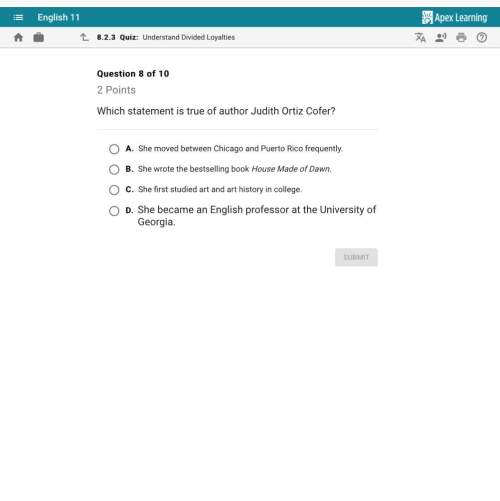(90 ! )ocean plastics
the perils of plastic
marine debris is a common pollution pr...

English, 26.09.2019 17:30 gizmo50245
(90 ! )ocean plastics
the perils of plastic
marine debris is a common pollution problem in oceans and waterways around the world. plastic debris constitutes one of the most serious threats to ocean health.
up to 90 percent of trash floating in the ocean and littering our shores is plastic. plastics can harm wildlife, damage coastal habitats, impact local economies, and even threaten human health.
how does plastic get into the ocean?
even if you don’t live near the coast, your plastic waste can still find its way to the ocean. a plastic water bottle blown into the street can travel down a stormwater sewer, into rivers and streams, and out into the ocean. since plastic never completely biodegrades, almost every piece of plastic ever produced is still in the environment in some form.
types of plastic
consumer products. plastic debris comes in many different types and sizes that we buy and use ourselves, including disposable water bottles, plastic grocery bags, fishing net, fishing line, plastic cups and lids, packaging, water balloons, and straws. in the marine environment, these types of debris can harm wildlife when animals mistake plastic for food, or accidentally entangle themselves in plastic littering our shorelines or floating in the ocean.
microplastics. plastic does not biodegrade. instead, once discarded into the environment, it breaks up into smaller and smaller pieces the longer it is exposed to the sun; a process called photodegradation. any plastic particle less than 5 mm in diameter is categorized as a microplastic. although small, these plastic pieces can have huge effects on ocean health.
effects of plastic
plastic poses a serious threat to our oceans and waterways. birds, turtles, fish, and other marine life ingest the plastic pieces, mistaking them for fish eggs, plankton, jellyfish, or other food sources. every year, hundreds of thousands of sea creatures, both large and small, die from complications relating to plastic debris—they may have a stomach full of plastic that they cannot digest, or they may become fatally entangled in debris.
harmful chemical pollutants can also attach to plastics and add to the toxicity of plastic debris consumed by animals. risks to human health from microplastics in seafood are currently being assessed.
source: national oceanic and atmospheric administration
read the article “ocean plastics.”
what is one of the author’s purposes in writing this piece?
a.
to inform people about the negative impacts of plastic pollution
b.
to persuade people to use only certain types of plastics
c.
to convince people that plastics should not be used
d.
to educate people about why plastic is the most harmful pollutant

Answers: 1
Another question on English

English, 22.06.2019 01:20
Which type of story uses animals as characters in order to illustrate a general truth about human nature?
Answers: 2

English, 22.06.2019 02:00
Why did the author include the fact that 40,000 african americans participated in the bus boycott
Answers: 2

English, 22.06.2019 08:00
"she is his achilles' heel" is an example allusion alliteration simile personification
Answers: 1

English, 22.06.2019 11:00
Excerpt from the trip of a lifetime elizabeth mohn 3 a little more than a week ago, my mother and father started packing our suitcases to prepare for our trip. my entire family woke up early sunday morning, packed the car, and began our expedition to niagara falls. when we reached the american-canadian border, i was excited to enter a foreign country for the first time. the third paragraph is mainly about a) traveling to niagara falls b) leaving the hotel. c) seeing the falls. d) returning home.
Answers: 2
You know the right answer?
Questions


Mathematics, 20.04.2021 18:20

Mathematics, 20.04.2021 18:20


Arts, 20.04.2021 18:20




Mathematics, 20.04.2021 18:20


Mathematics, 20.04.2021 18:20






Mathematics, 20.04.2021 18:20



Computers and Technology, 20.04.2021 18:20




